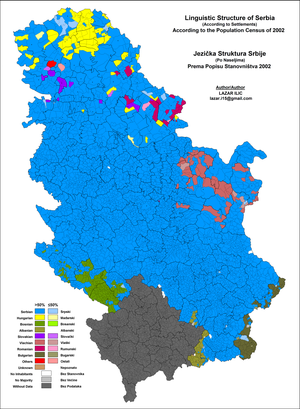
Serbo-Croatian – also called Serbo-Croat, Serbo-Croat-Bosnian (SCB), Bosnian-Croatian-Serbian (BCS), and Bosnian-Croatian-Montenegrin-Serbian (BCMS) – is a South Slavic language and the primary language of Serbia, Croatia, Bosnia and Herzegovina, and Montenegro. It is a pluricentric language with four mutually intelligible standard varieties, namely Serbian, Croatian, Bosnian, and Montenegrin.
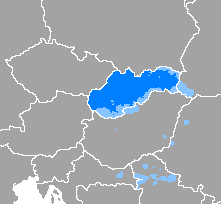
Slovak is a West Slavic language of the Czech–Slovak group, written in Latin script. It is part of the Indo-European language family, and is one of the Slavic languages, which are part of the larger Balto-Slavic branch. Spoken by approximately 5 million people as a native language, primarily ethnic Slovaks, it serves as the official language of Slovakia and one of the 24 official languages of the European Union.
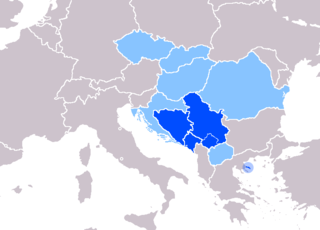
Serbian is the standardized variety of the Serbo-Croatian language mainly used by Serbs. It is the official and national language of Serbia, one of the three official languages of Bosnia and Herzegovina and co-official in Montenegro and Kosovo. It is a recognized minority language in Croatia, North Macedonia, Romania, Hungary, Slovakia, and the Czech Republic.
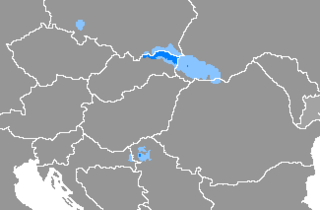
Rusyn is an East Slavic language spoken by Rusyns in parts of Central and Eastern Europe, and written in the Cyrillic script. Within the community, the language is also referred to by the older folk term, руснацькый язык, rusnac'kyj jazyk, 'Rusnak language', or simply referred to as speaking our way. The majority of speakers live in an area known as Carpathian Ruthenia that spans from Transcarpathia, westward into eastern Slovakia and south-east Poland. There is also a sizeable Pannonian Rusyn linguistic island in Vojvodina, Serbia, as well as a Rusyn diaspora throughout the world. Per the European Charter for Regional or Minority Languages, Rusyn is officially recognized as a protected minority language by Bosnia and Herzegovina, Croatia, Hungary, Romania, Poland, Serbia, and Slovakia.

Vojvodina, officially the Autonomous Province of Vojvodina, is an autonomous province that occupies the northernmost part of Serbia, located in Central Europe. It lies within the Pannonian Basin, bordered to the south by the national capital Belgrade and the Sava and Danube Rivers. The administrative center, Novi Sad, is the second-largest city in Serbia.

Church Slavonic, also known as Church Slavic, New Church Slavonic, New Church Slavic or just Slavonic, is the conservative Slavic liturgical language used by the Eastern Orthodox Church in Belarus, Bosnia and Herzegovina, Bulgaria, North Macedonia, Montenegro, Poland, Ukraine, Russia, Serbia, the Czech Republic and Slovakia, Slovenia and Croatia. The language appears also in the services of the Russian Orthodox Church Outside of Russia, the American Carpatho-Russian Orthodox Diocese, and occasionally in the services of the Orthodox Church in America.

The South Slavic languages are one of three branches of the Slavic languages. There are approximately 30 million speakers, mainly in the Balkans. These are separated geographically from speakers of the other two Slavic branches by a belt of German, Hungarian and Romanian speakers.

Shtokavian or Štokavian is the prestige supradialect of the pluricentric Serbo-Croatian language and the basis of its Serbian, Croatian, Bosnian and Montenegrin standards. It is a part of the South Slavic dialect continuum. Its name comes from the form for the interrogative pronoun for "what" što. This is in contrast to Kajkavian and Chakavian.

Vojvodina is a province in Republic of Serbia and one of the most ethnically diverse regions in Europe, home to 25 different ethnicities.

Romanians are a recognised national minority in Serbia. The total number of self-declared Romanians according to the 2022 census was 23,044, while 21,013 people declared themselves Vlachs; there are differing views among some of the Vlachs over whether they should be regarded as Romanians or as members of a distinctive nationality. Declared Romanians are mostly concentrated in Banat, in Vojvodina, while declared Vlachs are mostly concentrated in the Timok Valley, in eastern Serbia.

Torlakian, or Torlak, is a group of Eastern South Slavic dialects of southeastern Serbia, Kosovo, northeastern North Macedonia, and northwestern Bulgaria. Torlakian, together with Bulgarian and Macedonian, falls into the Balkan Slavic linguistic area, which is part of the broader Balkan sprachbund. According to UNESCO's list of endangered languages, Torlakian is vulnerable.
Languages of Yugoslavia are all languages spoken in former Yugoslavia. They are mainly Indo-European languages and dialects, namely dominant South Slavic varieties as well as Albanian, Aromanian, Czech, German, Italian, Venetian, Balkan Romani, Romanian, Pannonian Rusyn, Slovak and Ukrainian languages. There are also pockets where non-Indo-European languages such as Hungarian, Turkish, etc. varieties are spoken.

The languages spoken in Hungary include Hungarian, recognized minority languages, and other languages.
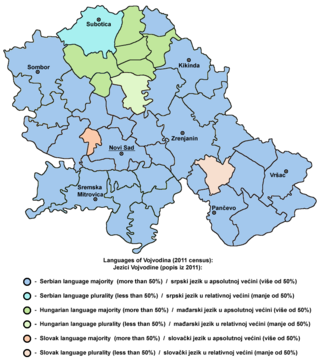
Languages and dialects spoken in the Serbian province of Vojvodina include South Slavic languages, West Slavic languages (Slovak), East Slavic languages (Rusyn), Hungarian, Romanian, Romani, and others.

The Romanian language is widely spoken in Serbia. This country hosts large native Romanian-speaking populations, which can be divided into the ethnic Romanians in the autonomous region of Vojvodina and the Romanian/Vlachs of the Timok Valley, a geographical region in Central Serbia. The former speak the Banat Romanian, identify as Romanians and have full rights within the autonomous region. Romanian is one of the six officially recognized languages of Vojvodina. Romanian/Vlachs speak archaic varieties of the Banat and Oltenian Romanian. Some of the members of community do not identify as Romanians and their language is not recognized as Romanian within Serbia. A "Vlach language" has gone under attempted standardization in the country, using a Cyrillic alphabet. This has been criticized in Romania, and attempts to bring Romanian-language resources and education to the Timok Vlachs have been blocked by the Serbian authorities.
Slavic microlanguages are literary linguistic varieties that exist alongside the better-known Slavic languages of historically prominent nations. The term "literary microlanguages" was coined by Aleksandr Dulichenko in late 1970s; it subsequently became a standard term in Slavistics.

Pannonian Rusyn, also historically referred to as Yugoslav Rusyn, is a variety of the Rusyn language, spoken by the Pannonian Rusyns, primarily in the regions of Vojvodina and Slavonia, and also in the Pannonian Rusyn diaspora in the United States and Canada. Since Rusyns are officially recognized as a national minority both in Serbia and Croatia, their language is also recognized as a minority language, and in the Autonomous Province of Vojvodina (Serbia) it is employed as one of six official provincial languages.

The dialects of Serbo-Croatian include the vernacular forms and standardized sub-dialect forms of Serbo-Croatian as a whole or as part of its standard varieties: Bosnian, Croatian, Montenegrin, and Serbian. They are part of the dialect continuum of South Slavic languages that joins through the transitional Torlakian dialects the Macedonian dialects to the south, Bulgarian dialects to the southeast and Slovene dialects to the northwest.
The ethnic groups in Yugoslavia were grouped into constitutive peoples and minorities.
The various regional and minority languages in Europe encompass four categories:
